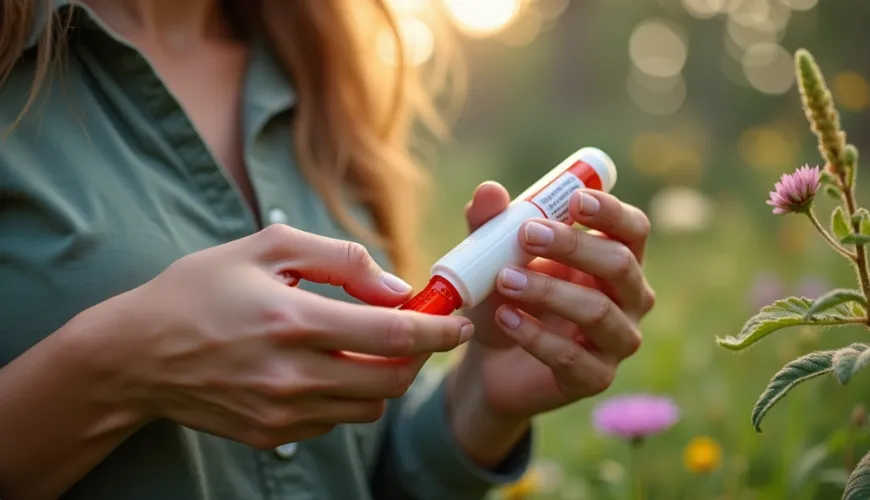
How to Recognize a Bee Sting Allergy and What to Do in Case of a Reaction

What You Should Know Before Experiencing an Allergic Reaction to a Bee Sting
The summer months invite outdoor activities, barbecues, picnics, and nature trips. However, along with these joys come certain risks, and one of them is contact with insects. While most people perceive a bee sting as merely an unpleasant, short-term pain, for some it can be a situation requiring immediate medical attention. An allergic reaction to a bee sting is a serious health issue that should not be underestimated.
Allergy to bee venom is an immune system overreaction to proteins present in the venom. For most people, a sting results in just redness, pain, and swelling at the site of the sting, but for those with allergies, it can lead to life-threatening anaphylaxis. According to the Czech Society of Allergology and Clinical Immunology (ČSAKI), sensitivity to stinging insect venom affects around 3% of the population, with the highest risk among people who are stung repeatedly, such as beekeepers or those who work frequently outdoors.
What Does an Allergic Reaction to a Bee Sting Look Like?
It's not uncommon for redness, itching, and swelling to appear at the sting site after being stung by a bee. This condition is completely normal and usually subsides within a few hours to days. However, if additional symptoms occur, it is necessary to be alert. Symptoms of an allergy to a bee sting vary in severity and may appear within minutes to hours after the sting.
Common and moderate reactions to a sting may include larger swelling – possibly over 10 centimeters, itching, rash, headaches, fatigue, or nausea.
When a severe allergic reaction occurs, it can be quite unpleasant – such as when the tongue, lips, or throat start to swell, breathing becomes difficult, wheezing occurs, the heart races, and blood pressure drops. In the worst-case scenario, it can even lead to loss of consciousness.
This form of allergy, scientifically known as anaphylaxis, is a life-threatening condition requiring immediate medical attention. If someone nearby suddenly loses consciousness, struggles to breathe, or has rashes and swelling all over their body after being stung by a bee, it is necessary to call emergency services immediately.
When the Body Overreacts
One reason why an allergy to a bee sting is so dangerous is its unpredictability. A person can be stung several times in life without major issues, and only on subsequent contact does a strong reaction occur. Allergies can also develop later – it is not something one must be born with.
An interesting example is the case of Mrs. Jana from Brno, who was stung by bees as a child several times without problems. However, at age 43, she was accidentally stung in the neck while gathering herbs and, within minutes, began experiencing chest pressure, weakness, and loss of consciousness. Thanks to the quick help of neighbors and subsequent treatment, she recovered, but since then she carries an adrenaline pen – a life-saving injection she can self-administer in case of a reaction.
Diagnosing and Treating Bee Venom Allergy
Treating an allergy to a bee sting begins with proper diagnosis. If unusual or severe symptoms appear after a sting, the individual should visit an allergist. The allergist can perform skin tests or blood tests for antibodies against bee venom.
If an allergy is detected, the standard procedure includes:
- Immunotherapy (bee vaccination) – a long-term treatment where the patient is gradually given increasing amounts of the allergen to teach the body not to overreact. This method is readily available in the Czech Republic and has a very high success rate.
- Adrenaline pen (epipen) – patients with a severe form of allergy should carry the pen at all times. In case of a reaction, they inject it into a muscle, significantly increasing the chances of survival until emergency services arrive.
- Antihistamines and corticosteroids – may be prescribed for milder cases or as a supplement to the main treatment.
Prevention also involves avoiding risky situations – for example, not wearing strong perfumes or brightly colored clothing in summer, which might attract bees.
What to Do When Stung by a Bee?
If contact with a bee occurs, the first and most important step is to remove the stinger as soon as possible. When a bee stings, it leaves not only the stinger but also the venom sac in the skin, continuing to pump venom into the body. Scraping the stinger off with a fingernail or credit card is ideal – avoid tweezers, which can squeeze the venom sac and release more venom.
If you get stung, initial first aid is quite simple – just rinse the affected area with cold water, soothe it with ice wrapped in cloth, and then apply gel or ointment against itching, ideally containing antihistamine.
If signs of an allergic reaction appear, it's crucial to administer medication quickly and call emergency services.
Sometimes it can be difficult to distinguish a normal reaction from an allergic one. While a common swelling subsides within a few hours, a systemic allergic reaction spreads beyond the sting site and can affect the entire body. Therefore, it's important to monitor your body and seek medical attention if in doubt.
Living with an Allergy
For people with a severe allergy to bee stings, every trip into nature can be stressful. However, thanks to modern medicine and available prevention, it's possible to live a full life with this diagnosis. The key is knowledge, preparedness, and awareness of one's limits.
Families with an allergic child should be cautious but not restrict the child from all activities. It's important for the child and their surroundings (school, camp, leaders) to know how to react appropriately in the event of a sting. In some preschools and primary schools today, trained staff in first aid, including adrenaline application, is common practice.
A sensitive yet practical approach was summarized by doctor and allergist MUDr. Eva Novotná: "Allergy to insect stings is serious, but it's not the end of the world. When one knows what to do, they can prevent the worst."
Interestingly, some research suggests that regular contact with nature and natural exposure to bee venom in the form of immunotherapy can strengthen the immune system and reduce the body's reaction in selected patients. However, always under professional supervision.
Whether you're a regular visitor to the woods or just spending the weekend at a cottage, it's good to remember that a small sting can have big consequences. Knowing when it's just a minor nuisance and when it's a real threat can save a life – your own and others'.

